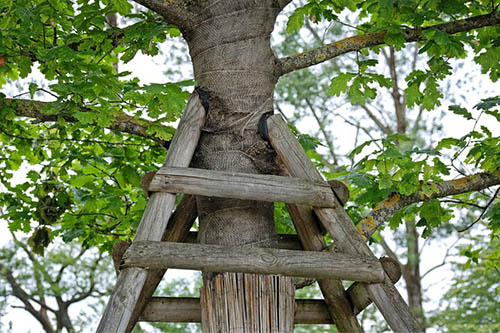Tree Cabling & Bracing in Euless, TX

Expert Tree Cabling and Bracing Team
You might be asking yourself what tree cabling and bracing is, and Euless Tree Service is more than happy to answer all your questions. For now, though, we’ll give you a simple overview of our tree cabling-bracing services.
Tree cabling and bracing is the practice of installing slightly flexible steel strand cables and braces in trees to help alleviate any stress related to high winds, the weight of snow or ice, or even from the tree’s own heavy foliage. This is especially important in Texas where severe weather runs rampant and large trees are common.
When we apply tree cabling and bracing we are basically providing the tree with a supplemental support system. This functions as a way to limit movement during storms and other severe weather so they don’t fall off and cause further damage to your property and your tree. Tree cabling and bracing acts like the casts we wear after we’ve broken a bone. Wearing a cast limits the movement surrounding the broken bone so it can heal correctly, just like a tree needs to keep its branches and other limbs from ripping from the trunk.
How Do You Know if You Need Tree Cabling and Bracing?
Quite simply, you don’t. Determining whether or not you need to cable and brace your tree is not obvious to the untrained eye. Euless Tree Service has expert arborists who are trained to determine if your tree needs cabling and bracing. We’ll come to assess and inspect your tree to see if cabling and bracing is the right solution for you.
Reasons For Cabling and Bracing Your Trees
There are several reasons cabling and bracing your trees is a good idea. Perhaps you have recently purchased a tree sapling or you have a large tree near your house. Every tree is different and they have different needs. Sometimes cabling and bracing will actually hurt your tree rather than help it. Let Euless Tree Service’s licensed arborists come to assess your unique needs.
Some key things to look for when you are considering tree cabling and bracing include:
- Cracked, snapped, or sagging branches
- Leaning trunk and/or exposed and uplifted roots
- Irregular swaying during high winds
- Creaking or crackling under the weight of snow/ice
- Any splitting or separation of the trunk or at branch connection
Types of Tree Cabling
Tree cabling is used most often to provide support for trees that have a type of structural defect or weakness that could cause further problems if severe weather pushes against the upper canopy. Cabling serves as a way to limit any swaying of branches while also redistributing any structural stress more evenly.
There are two types of tree cabling:
- Static Cabling
- This method is typically used to repair or provide more support in trees that have existing problems
- Restricts any and all movement or swaying of the upper tree canopy
- Uses the highest strength steel cables that have no leniency
- Dynamic Cabling
- This method is most commonly implemented as a preventative measure
- Allows plenty of movement as the tree sways with the wind
- Uses a more elastic type of braided steel cable
Tree Bracing in Euless, TX
Tree bracing is more commonly performed in the lower section of the tree, rather than the canopy. It functions as a way to reinforce any flaws or faults in the tree’s structure, which can include:
- Split unions
- Cracked trunks
- Holes and cavities
- Weak branch attachments
- Ingrown bark
Tree bracing is an invasive process that requires steel rods to be installed or installed above and below the damaged area. Tree bracing and cabling are generally used together to provide maximum support to even your most damaged trees.

